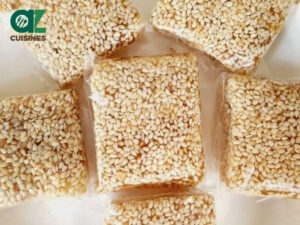#132 in Vietnam
Bánh Cáy: Ingredients and Preparation
Main Ingredients
Main Cooking Method
Preparation Process
Bánh Cáy: A Deep Dive
Cultural Significance
Taste
Texture
Aroma
Color
Serving Style
Serving Temperature
Accompaniment
Occasions
Seasons
Special Diets
Calories
Popularity
Popular Similar Dishes
Popular Dining Area
Bánh cáy is a traditional specialty of Nguyen Village in Dong Hung District, Thai Binh Province in Vietnam.
Bánh cáy is made from high-quality sticky rice (ideally yellow flower sticky rice), combined with gấc fruit (spiny bitter gourd) for red color and dành dành fruit (Gardenia jasminoides) for yellow color.
Other components in bánh cáy are pork lard, peanuts, sesame seeds, carrot, ginger, mandarin orange peels, sugar, and sugarcane molasses.
Its yellow-reddish color resembles the eggs of cáy (a type of small crab living in Northern Vietnam), hence the name “bánh cáy.”
There is also another legend that bánh cáy contained ginger which offers a spicy taste and was called “bánh cay” (spicy cake).
After cooking, the sticky rice is pounded into a smooth, doughy texture, then dried and shaped into small pieces.
Bánh cáy is best enjoyed with tea, making this duo a favorite treat in the New Year in Thai Binh
.The tale behind bánh cáy is very interesting, rooted in Vietnam’s imperial era, which I’ll introduce in the following part. Following this, you’ll have a sneak peek at how locals prepare this treat.
Additionally, there are advantages and disadvantages of bánh cáy that you need to consider before eating it.
In case you still have any lingering curiosities about this Thai Binh specialty, check out the FAQs section. And lastly, don’t miss out on other delicacies that share some similarities to bánh cáy.
Key Points
What Is the Tale Of Bánh Cáy?
The story behind bánh cáy begins with Nguyen Thi Tan, who was born into a respected family in 1725. She became a royal nurse to Prince Le Duy Vy, a son of King Le Hien Tong. In 1769, the Prince was imprisoned, and Nguyen Thi Tan was his sole visitor.
The Prince expressed that he couldn’t eat the prison food. As a skilled cook, Tan secretly provided food for the Prince. Knowing that the Prince’s health was not good and he couldn’t digest simple foods, she used ingredients like ginger, beans, and peanuts to create a small, long-lasting, and nutritious cake.
After several years, Tan retired to her village and shared her knowledge of how to make this cake with others. Over time, this recipe was widely shared and eventually evolved into a special delicacy presented to the King.
Even after the Prince’s release and ascension to the throne, the tradition of making bánh cáy in Nguyen Village continued, honoring Tan’s contribution. However, making bánh cáy is a complex process, featuring the cultural heritage and culinary skills passed down through generations.
How Do Locals Make Bánh Cáy?
The preparation of bánh cáy begins about half a month in advance by marinating finely chopped pork lard with sugar to develop a deep flavor. This mix is later sautéed until crispy. Other components like peanuts and sesame seeds are roasted and then peeled. They also sauté carrots, ginger, and mandarin orange peels with sugar and set aside.
The cooked yellow flowered sticky rice used in bánh cáy is divided into three parts. One part is for making coloring half with gac fruit for redness, and half with gardenia water for yellow. Then, both types are mixed, finely pounded, thinly spread, cut into strips, and dried. The rest of the sticky rice is roasted in a hot pan until it puffs up into popped rice.
Finally, locals blend these components with sugarcane molasses in a pan, stirring until aromatic. Spoon the mixture into sesame-lined molds to shape, and once hardened, remove and coat with sesame seeds.
Obviously, making bánh cáy is not an ideal recipe for home cooking as it requires many steps and local ingredients. However, despite the complex making process, bánh cáy’s distinctive flavor and other good sides are worth considering, as I’ll discuss next.
Pros and Cons of Eating Bánh Cáy
Let’s evaluate the upsides and downsides of bánh cáy with the below table.
Pros
Cons
Also, it’s crucial to review other questions that are often asked about this Thai Binh treat.





Truc Tran (Kris)
Senior Food Editor
Expertise
Home Cooking, Meal Planning, Recipe Development, Baking and Pastry, Food Editor, Cooking-video Maker, Vietnamese Food Evaluation Expert
Education
Truc Tran (Kris), an experienced food writer and editor, is great at exploring and describing global cuisines, from simple street food to fancy dining. In her writing, she skillfully mixes different flavors, cooking methods, and culinary traditions, showing the unique character of various cultures through their food and drinks. On azcuisines.com, Kris highlights her knowledge, especially in Asian cuisine and worldwide traditional dishes.